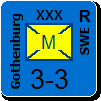marcuswatney
Posts: 279
Joined: 2/28/2006
Status: offline

|
As a Briton, I was rather surprised (and uncomfortable) to see 'Territorials' appearing in MWiF, as the name feels anachronistic. The present day Territorials (or TAVR = Territorial And Volunteer Reserves, to give them their full title) are highly respected and are much more than mere militia. At first glance, they might appear to have similarities with America's National Guard, but the position is rather more subtle: the TAVR would never be used at home to quell civil unrest (thoughts of Kent State University) and do expect to serve alongside Regular units abroad. They are being rotated through Iraq at the moment.
The thinking behind the modern TAVR was that a war in Europe in the sixties and seventies would be so intense and so fast that there wouldn't be time to mobilise retired soldiers on the reserves-list or conscript civilians. So the TAVR was trained to work alongside the BAOR (joint exercises etc) and were to be shipped out within days of a crisis.
The men and women of the TAVR are paid for their weekends training and must also be willing to go on exercise for a week or two each year. But one of the great attractions of the TAVR is that bosses approve strongly of that sort of commitment, so it definitely helps your civilian career too.
But I think the situation in the Second World War was very much different, particularly since there was conscription. Almost the entire British Army is organised on the regimental system and always has been. So that long list of place names in Post 644 isn't a feature merely of 'Territorial' units. My father, for example, joined the Royal Sussex Regiment as a Regular, and although he transferred to a variety of duties during the war, ending up with a unit called Phantom, he was always somehow listed with the Royal Sussex (and he was a Londoner!)
So in the Second World War, I wouldn't take the designation 'Territorial' to have any practical meaning at all. For example, I see in that list of 'Territorials' the 43rd (Wessex) Division, which was part of XXX Corps' drive up Hells Highway, and 52nd (Lowland) Division, which was the air-landing division tasked to land at Deelen airfield northwest of Arnhem as soon as 1st Airborne had secured it.
All British units in that list would have been required to serve wherever they were posted, so they were not 'Territorial' in the sense of MWiF.
The one anomaly was the Indian Army, which was organised as an entirely autonomous entity. At Imphal-Kohima for example, one of the divisions is designated British to show that it was part of the British Army rather than the Indian Army.
< Message edited by marcuswatney -- 2/12/2008 1:52:13 PM >
|
 Printable Version
Printable Version














 Better write more than less I say, as long as it is entertaining and somewhat accurate.
Better write more than less I say, as long as it is entertaining and somewhat accurate. 

 New Messages
New Messages No New Messages
No New Messages Hot Topic w/ New Messages
Hot Topic w/ New Messages Hot Topic w/o New Messages
Hot Topic w/o New Messages Locked w/ New Messages
Locked w/ New Messages Locked w/o New Messages
Locked w/o New Messages Post New Thread
Post New Thread